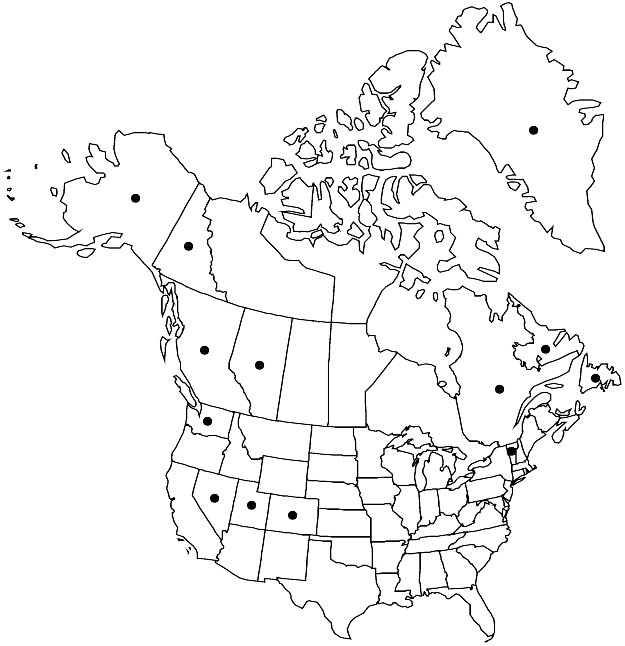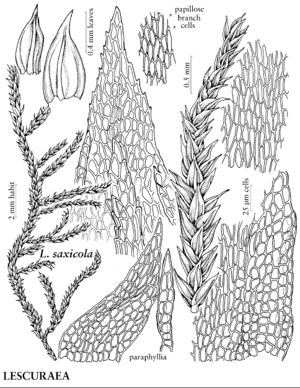Difference between revisions of "Lescuraea saxicola"
in P. G. Lorentz, Moosstudien, 144, 147, 149. 1864.
FNA>Volume Importer |
FNA>Volume Importer |
||
| Line 18: | Line 18: | ||
|name=L. iliamniana | |name=L. iliamniana | ||
|authority=Bescherelle & Car dot | |authority=Bescherelle & Car dot | ||
| − | }}{{Treatment/ID/Synonym | + | }} {{Treatment/ID/Synonym |
|name=L. julacea | |name=L. julacea | ||
|authority=unknown | |authority=unknown | ||
| Line 36: | Line 36: | ||
|elevation=moderate to high elevations (200-3400 m) | |elevation=moderate to high elevations (200-3400 m) | ||
|distribution=Greenland;Alta.;B.C.;Nfld. and Labr.;Que.;Yukon;Alaska;Colo.;Nev.;Utah;Vt.;Wash.;n Europe;Asia (China;India;Japan;n Russia). | |distribution=Greenland;Alta.;B.C.;Nfld. and Labr.;Que.;Yukon;Alaska;Colo.;Nev.;Utah;Vt.;Wash.;n Europe;Asia (China;India;Japan;n Russia). | ||
| − | |discussion=<p>Lescuraea saxicola is distinguished from most species of Pseudoleskea by its elongate, thin-walled medial laminal cells, and from P. baileyi in lacking a hair-point.</p> | + | |discussion=<p><i>Lescuraea saxicola</i> is distinguished from most species of <i>Pseudoleskea</i> by its elongate, thin-walled medial laminal cells, and from <i>P. baileyi</i> in lacking a hair-point.</p> |
|tables= | |tables= | ||
|references= | |references= | ||
| Line 60: | Line 60: | ||
|publication year=1864 | |publication year=1864 | ||
|special status=Selected by author to be illustrated | |special status=Selected by author to be illustrated | ||
| − | |source xml=https://jpend@bitbucket.org/aafc-mbb/fna-data-curation.git/src/ | + | |source xml=https://jpend@bitbucket.org/aafc-mbb/fna-data-curation.git/src/8f726806613d60c220dc4493de13607dd3150896/coarse_grained_fna_xml/V28/V28_542.xml |
|genus=Lescuraea | |genus=Lescuraea | ||
|species=Lescuraea saxicola | |species=Lescuraea saxicola | ||
Revision as of 18:06, 18 September 2019
Stems golden or orange with age, weakly appressed to substrate, branches many, curved to erect, often hooked at apices; paraphyllia not much branched, sometimes nearly absent. Stem leaves not catenulate, irregular, asymmetric, weakly falcate-secund, lustrous, weakly to strongly concave, distinctly 1 (or 2)-plicate, 0.7–1.4 mm; costa orange at least at base, distal abaxial surface serrulate; alar cells smooth, walls thin, region small; proximal laminal cells usually smooth; medial cells 14–50 × 4–7 µm, slightly shorter and wider proximally; apical cells strongly prorate. Branch leaves with medial and distal laminal cells more strongly prorulose. Seta yellow-orange, slender, flexuose. Capsule yellow-orange to red-brown, 1–2 mm; exostome teeth not bordered.
Phenology: Capsules rare, mature summer (Jul–Aug).
Habitat: Granitic or sandstone boulders, outcrops, exposed mineral soil, seepage areas in subalpine and arctic-alpine regions
Elevation: moderate to high elevations (200-3400 m)
Distribution

Greenland, Alta., B.C., Nfld. and Labr., Que., Yukon, Alaska, Colo., Nev., Utah, Vt., Wash., n Europe, Asia (China, India, Japan, n Russia).
Discussion
Lescuraea saxicola is distinguished from most species of Pseudoleskea by its elongate, thin-walled medial laminal cells, and from P. baileyi in lacking a hair-point.
Selected References
None.
